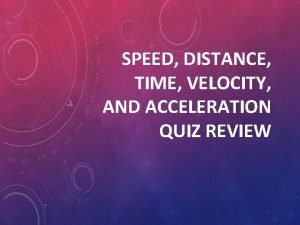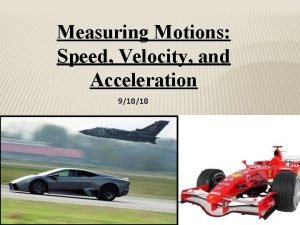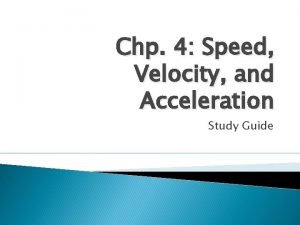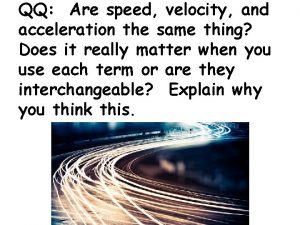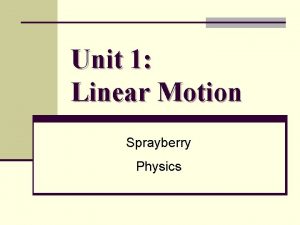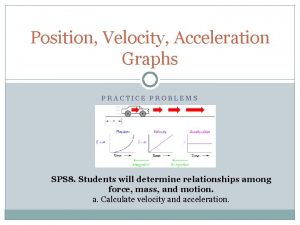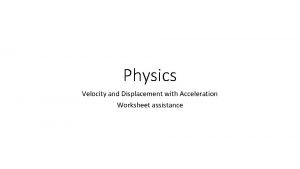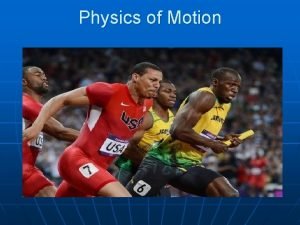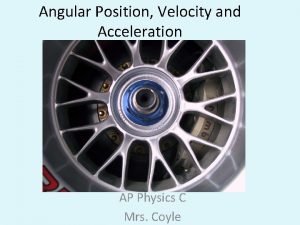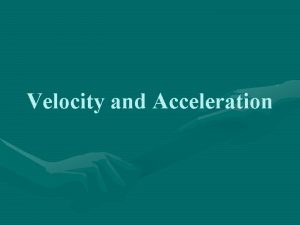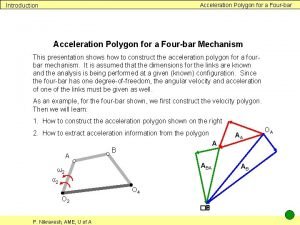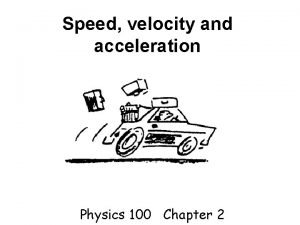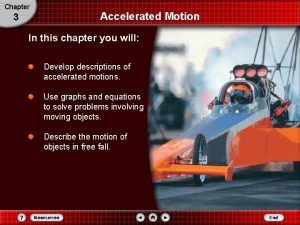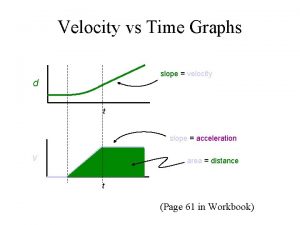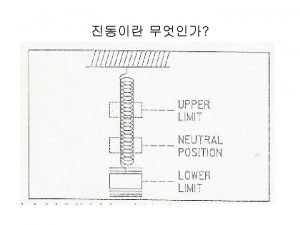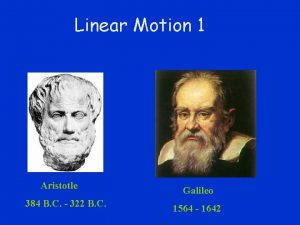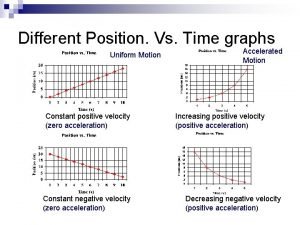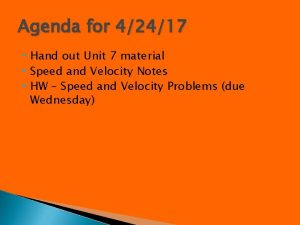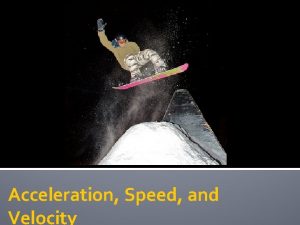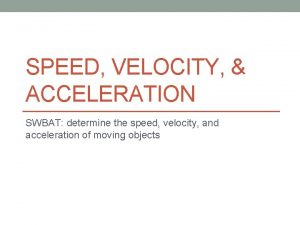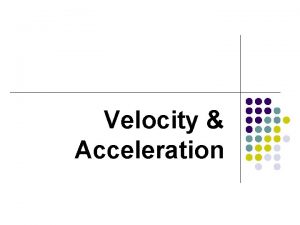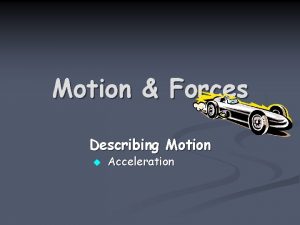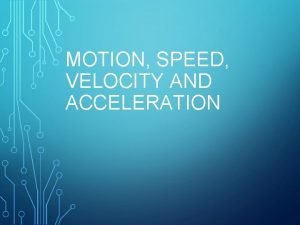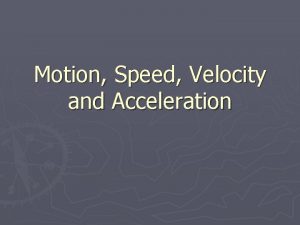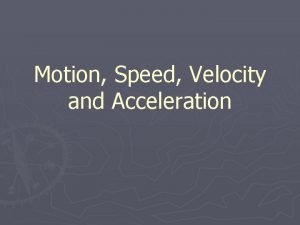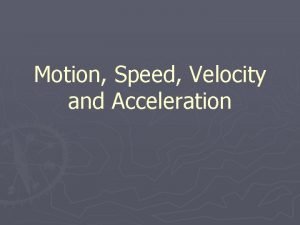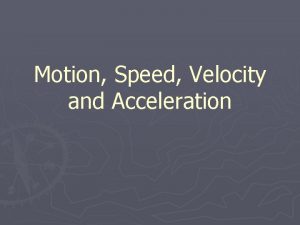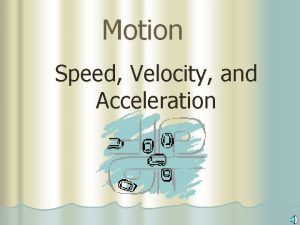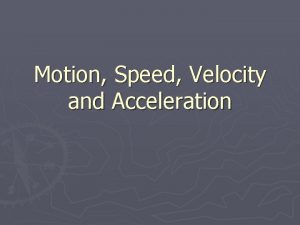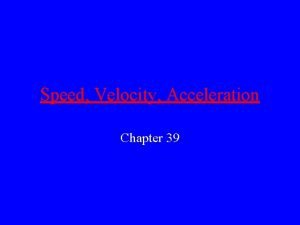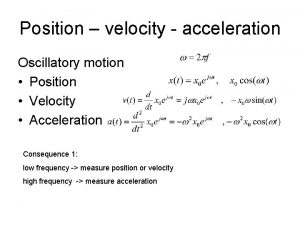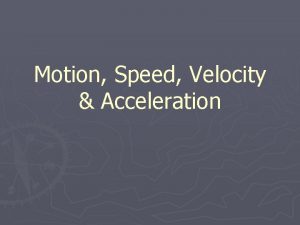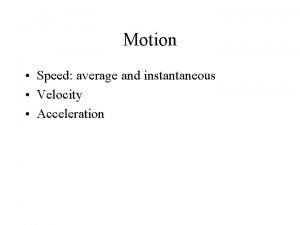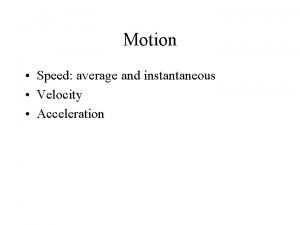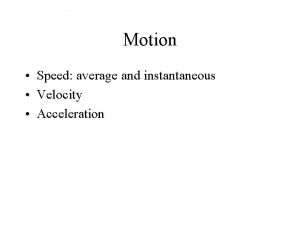Forces and Motion Forces Acceleration Motion Velocity Speed






































- Slides: 38

Forces and Motion

Forces Acceleration Motion Velocity Speed Team1 Team2

A force is a ____ or a ____.

A force is a ____ or a ____. Answer: A push or a pull.

Balanced forces produce a net force of _____.

Balanced forces produce a net force of _____. Answer: zero

Rolling friction is usually A. less than B. more than C. equal to sliding friction.

Rolling friction is usually A. less than B. more than C. equal to sliding friction. Answer: Less than

Unbalanced forces are necessary to cause a change in _____.

Unbalanced forces are necessary to cause a change in _____. Answer: motion

You can run 100 meters in 10 seconds. What is your speed?

You can run 100 meters in 10 seconds. What is your speed? Answer: 10 m/s

An example of acceleration is: A. a hovering helicopter B. a car turning a corner C. bicycling at 40 m/s

An example of acceleration is: A. a hovering helicopter B. a car turning a corner C. bicycling at 40 m/s Answer: A car turning a corner

_____ friction includes both liquids and gases.

_____ friction includes both liquids and gases. Answer: Fluid

A student riding her bicycle on a straight, flat road covers one block every 7 seconds. If each block is 100 m long, she is traveling at _____ speed or velocity.

A student riding her bicycle on a straight, flat road covers one block every 7 seconds. If each block is 100 m long, she is traveling at _____ speed or velocity. Answer: constant

A force is expressed in ______.

A force is expressed in ______. Answer: Newtons

If a bus traveling 15 m/s south speeds up to 20 m/s, this is a change in _____.

If a bus traveling 15 m/s south speeds up to 20 m/s, this is a change in _____. Answer: speed or velocity or acceleration

Acceleration is the rate of change in ______.

Acceleration is the rate of change in ______. Answer: velocity (also accept speed or direction)

The distance divided by the time it took to travel that distance is an object’s _____.

The distance divided by the time it took to travel that distance is an object’s _____. Answer: speed

When you combine all forces acting on an object you get the ______.

When you combine all forces acting on an object you get the ______. Answer: net force

_____ is a force that opposes motion.

_____ is a force that opposes motion. Answer: Friction

What is the net force when you combine a force of 7 N north with a force of 2 N south?

What is the net force when you combine a force of 7 N north with a force of 2 N south? Answer: 5 N north

Moving blades of a windmill or a pinwheel are example of ______ acceleration.

Moving blades of a windmill or a pinwheel are example of ______ acceleration. Answer: centripetal

Decreasing velocity can be referred to as: A. acceleration B. deceleration C. negative acceleration D. All of the above.

Decreasing velocity can be referred to as: A. acceleration B. deceleration C. negative acceleration D. All of the above. Answer: D. all of the above

Are the forces on a kicked soccer ball balanced or unbalanced? How do you know?

Are the forces on a kicked soccer ball balanced or unbalanced? How do you know? Answer: Unbalanced because the ball changes speed and/or direction.
 Speed and velocity quiz
Speed and velocity quiz Speed velocity and acceleration problems answers
Speed velocity and acceleration problems answers Speed, velocity and acceleration formula
Speed, velocity and acceleration formula Speed velocity and acceleration study guide answers
Speed velocity and acceleration study guide answers What is the difference between speed and velocity
What is the difference between speed and velocity Are speed velocity and acceleration the same thing
Are speed velocity and acceleration the same thing What is acceleration
What is acceleration Final velocity initial velocity acceleration time
Final velocity initial velocity acceleration time What does constant acceleration mean
What does constant acceleration mean Angular acceleration and linear acceleration
Angular acceleration and linear acceleration Linear acceleration
Linear acceleration Tangential acceleration and centripetal acceleration
Tangential acceleration and centripetal acceleration Linear motion definition
Linear motion definition Velocity
Velocity Relative velocity and acceleration
Relative velocity and acceleration Distance velocity acceleration graphs
Distance velocity acceleration graphs Displacement and velocity worksheet
Displacement and velocity worksheet Difference between velocity and acceleration
Difference between velocity and acceleration Quickchek menu
Quickchek menu Angular position velocity and acceleration
Angular position velocity and acceleration Acceleration polygon
Acceleration polygon Describes both speed and direction
Describes both speed and direction Collision forces quick check
Collision forces quick check Velocity polygon
Velocity polygon Velocity and acceleration
Velocity and acceleration Velocity vs speed formula
Velocity vs speed formula Physics chapter 3 accelerated motion test
Physics chapter 3 accelerated motion test Centripetal acceleration ac
Centripetal acceleration ac Radial acceleration
Radial acceleration Initial velocity and final velocity formula
Initial velocity and final velocity formula Distance is speed over time
Distance is speed over time Velocity vs acceleration
Velocity vs acceleration Velocity acceleration derivative
Velocity acceleration derivative Vibration displacement velocity acceleration
Vibration displacement velocity acceleration Negative velocity negative acceleration
Negative velocity negative acceleration Uniform motion graphs
Uniform motion graphs Dt
Dt Constant speed on distance time graph
Constant speed on distance time graph Speed challenge lab
Speed challenge lab
